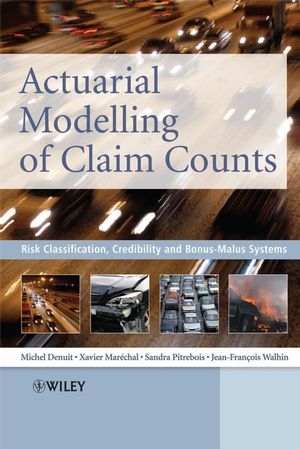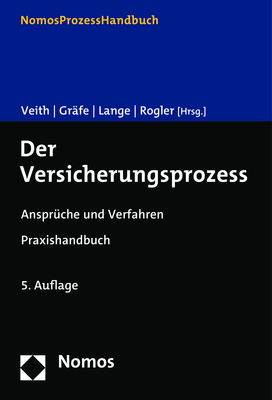
Actuarial Modelling of Claim Counts
Wiley-Interscience (Verlag)
978-0-470-02677-9 (ISBN)
There are a wide range of variables for actuaries to consider when calculating a motorist’s insurance premium, such as age, gender and type of vehicle. Further to these factors, motorists’ rates are subject to experience rating systems, including credibility mechanisms and Bonus Malus systems (BMSs). Actuarial Modelling of Claim Counts presents a comprehensive treatment of the various experience rating systems and their relationships with risk classification. The authors summarize the most recent developments in the field, presenting ratemaking systems, whilst taking into account exogenous information.
The text:
Offers the first self-contained, practical approach to a priori and a posteriori ratemaking in motor insurance.
Discusses the issues of claim frequency and claim severity, multi-event systems, and the combinations of deductibles and BMSs.
Introduces recent developments in actuarial science and exploits the generalised linear model and generalised linear mixed model to achieve risk classification.
Presents credibility mechanisms as refinements of commercial BMSs.
Provides practical applications with real data sets processed with SAS software.
Actuarial Modelling of Claim Counts is essential reading for students in actuarial science, as well as practicing and academic actuaries. It is also ideally suited for professionals involved in the insurance industry, applied mathematicians, quantitative economists, financial engineers and statisticians.
Michel Denuit – Professor, Institute of Actuarial Science, UCL, Belgium. Michel Denuit is Professor of Statistics and Actuarial Science at the Université Catholique de Louvain, Belgium. His major fields of research are risk theory and stochastic inequalities. He has (co-)authored numerous articles that have appeared in applied and theoretical journals and served as member of the editorial board for several journals (including Insurance: Mathematics and Economics). He is a section editor on Wiley’s Encyclopedia of Actuarial Science, and is the author of two previous books, one of them with Wiley. Xavier Maréchal – Université Catholique de Louvain, Belgium & CEO of Reacfin, Belgium. Sandra Pitrebois – Université Catholique de Louvain, Belgium & Secura Belgian Re, Brussels. Jean-François Walhin – Université Catholique de Louvain, Belgium & Secura Belgian Re, Brussels
Foreword xiii
Preface xv
Notation xxv
Part I Modelling Claim Counts 1
1 Mixed Poisson Models for Claim Numbers 3
1.1 Introduction 3
1.1.1 Poisson Modelling for the Number of Claims 3
1.1.2 Heterogeneity and Mixed Poisson Model 4
1.1.3 Maximum Likelihood Estimation 4
1.1.4 Agenda 5
1.2 Probabilistic Tools 5
1.2.1 Experiment and Universe 5
1.2.2 Random Events 5
1.2.3 Sigma-Algebra 6
1.2.4 Probability Measure 6
1.2.5 Independent Events 7
1.2.6 Conditional Probability 7
1.2.7 Random Variables and Random Vectors 8
1.2.8 Distribution Functions 8
1.2.9 Independence for Random Variables 9
1.3 Poisson Distribution 10
1.3.1 Counting Random Variables 10
1.3.2 Probability Mass Function 10
1.3.3 Moments 10
1.3.4 Probability Generating Function 11
1.3.5 Convolution Product 12
1.3.6 From the Binomial to the Poisson Distribution 13
1.3.7 Poisson Process 17
1.4 Mixed Poisson Distributions 21
1.4.1 Expectations of General Random Variables 21
1.4.2 Heterogeneity and Mixture Models 22
1.4.3 Mixed Poisson Process 25
1.4.4 Properties of Mixed Poisson Distributions 26
1.4.5 Negative Binomial Distribution 28
1.4.6 Poisson-Inverse Gaussian Distribution 31
1.4.7 Poisson-LogNormal Distribution 33
1.5 Statistical Inference for Discrete Distributions 35
1.5.1 Maximum Likelihood Estimators 35
1.5.2 Properties of the Maximum Likelihood Estimators 37
1.5.3 Computing the Maximum Likelihood Estimators with the Newton–Raphson Algorithm 40
1.5.4 Hypothesis Tests 41
1.6 Numerical Illustration 44
1.7 Further Reading and Bibliographic Notes 46
1.7.1 Mixed Poisson Distributions 46
1.7.2 Survey of Empirical Studies Devoted to Claim Frequencies 46
1.7.3 Semiparametric Approach 47
2 Risk Classification 49
2.1 Introduction 49
2.1.1 Risk Classification, Regression Models and Random Effects 49
2.1.2 Risk Sharing in Segmented Tariffs 50
2.1.3 Bonus Hunger and Censoring 51
2.1.4 Agenda 52
2.2 Descriptive Statistics for Portfolio A 52
2.2.1 Global Figures 52
2.2.2 Available Information 52
2.2.3 Exposure-to-Risk 53
2.2.4 One-Way Analyses 54
2.2.5 Interactions 58
2.2.6 True Versus Apparent Dependence 59
2.3 Poisson Regression Model 62
2.3.1 Coding Explanatory Variables 62
2.3.2 Loglinear Poisson Regression Model 64
2.3.3 Score 64
2.3.4 Multiplicative Tariff 65
2.3.5 Likelihood Equations 66
2.3.6 Interpretation of the Likelihood Equations 67
2.3.7 Solving the Likelihood Equations with the Newton–Raphson Algorithm 67
2.3.8 Wald Confidence Intervals 69
2.3.9 Testing for Hypothesis on a Single Parameter 69
2.3.10 Confidence Interval for the Expected Annual Claim Frequency 70
2.3.11 Deviance 71
2.3.12 Deviance Residuals 72
2.3.13 Testing a Hypothesis on a Set of Parameters 72
2.3.14 Specification Error and Robust Inference 72
2.3.15 Numerical Illustration 73
2.4 Overdispersion 79
2.4.1 Explanation of the Phenomenon 79
2.4.2 Interpreting Overdispersion 79
2.4.3 Consequences of Overdispersion 80
2.4.4 Modelling Overdispersion 80
2.4.5 Detecting Overdispersion 81
2.4.6 Testing for Overdispersion 82
2.5 Negative Binomial Regression Model 83
2.5.1 Likelihood Equations 83
2.5.2 Numerical Illustration 85
2.6 Poisson-Inverse Gaussian Regression Model 86
2.6.1 Likelihood Equations 86
2.6.2 Numerical Illustration 86
2.7 Poisson-LogNormal Regression Model 87
2.7.1 Likelihood Equations 87
2.7.2 Numerical Illustration 88
2.8 Risk Classification for Portfolio A 89
2.8.1 Comparison of Competing models with the Vuong Test 89
2.8.2 Resulting Risk Classification for Portfolio A 90
2.9 Ratemaking using Panel Data 90
2.9.1 Longitudinal Data 90
2.9.2 Descriptive Statistics for Portfolio B 92
2.9.3 Poisson Regression with Serial Independence 94
2.9.4 Detection of Serial Dependence 97
2.9.5 Estimation of the Parameters using GEE 101
2.9.6 Maximum Likelihood in the Negative Binomial Model for Panel Data 105
2.9.7 Maximum Likelihood in the Poisson-Inverse Gaussian Model for Panel Data 106
2.9.8 Maximum Likelihood in the Poisson-LogNormal Model for Panel Data 107
2.9.9 Vuong Test 109
2.9.10 Information Criteria 110
2.9.11 Resulting Classification for Portfolio B 110
2.10 Further Reading and Bibliographic Notes 111
2.10.1 Generalized Linear Models 111
2.10.2 Nonlinear Effects 112
2.10.3 Zero-Inflated Models 112
2.10.4 Fixed Versus Random Effects 113
2.10.5 Hurdle Models 113
2.10.6 Geographic Ratemaking 114
2.10.7 Software 116
Part II Basics of Experience Rating 119
3 Credibility Models for Claim Counts 121
3.1 Introduction 121
3.1.1 From Risk Classification to Experience Rating 121
3.1.2 Credibility Theory 121
3.1.3 Limited Fluctuation Theory 122
3.1.4 Greatest Accuracy Credibility 122
3.1.5 Linear Credibility 123
3.1.6 Financial Equilibrium 123
3.1.7 Combining a Priori and a Posteriori Ratemaking 123
3.1.8 Loss Function 124
3.1.9 Agenda 124
3.2 Credibility Models 124
3.2.1 A Simple Introductory Example: the Good Driver / Bad Driver Model 124
3.2.2 Credibility Models Incorporating a Priori Risk Classification 126
3.3 Credibility Formulas with a Quadratic Loss Function 128
3.3.1 Optimal Least-Squares Predictor 128
3.3.2 Predictive Distribution 129
3.3.3 Bayesian Credibility Premium 130
3.3.4 Poisson-Gamma Credibility Model 131
3.3.5 Predictive Distribution and Bayesian Credibility Premium 132
3.3.6 Numerical Illustration 133
3.3.7 Discrete Poisson Mixture Credibility Model 135
3.3.8 Discrete Approximations for the Heterogeneous Component 136
3.3.9 Linear Credibility 144
3.4 Credibility Formulas with an Exponential Loss Function 149
3.4.1 Optimal Predictor 149
3.4.2 Poisson-Gamma Credibility Model 151
3.4.3 Linear Credibility 152
3.4.4 Numerical Illustration 152
3.5 Dependence in the Mixed Poisson Credibility Model 155
3.5.1 Intuitive Ideas 155
3.5.2 Stochastic Order Relations 156
3.5.3 Comparisons of Predictive Distributions 156
3.5.4 Positive Dependence Notions 157
3.5.5 Dependence Between Annual Claim Numbers 157
3.5.6 Increasingness in the Linear Credibility Model 158
3.6 Further Reading and Bibliographic Notes 158
3.6.1 Credibility Models 158
3.6.2 Claim Count Distributions 159
3.6.3 Loss Functions 159
3.6.4 Credibility and Regression Models 159
3.6.5 Credibility and Copulas 160
3.6.6 Time Dependent Random Effects 161
3.6.7 Credibility and Panel Data Models 162
3.6.8 Credibility and Empirical Bayes Methods 163
4 Bonus-Malus Scales 165
4.1 Introduction 165
4.1.1 From Credibility to Bonus-Malus Scales 165
4.1.2 The Nature of Bonus-Malus Scales 166
4.1.3 Relativities 166
4.1.4 Bonus-Malus Scales and Markov Chains 166
4.1.5 Financial Equilibrium 167
4.1.6 Agenda 167
4.2 Modelling Bonus-Malus Systems 168
4.2.1 Typical Bonus-Malus Scales 168
4.2.2 Characteristics of Bonus-Malus Scales 169
4.2.3 Trajectory 170
4.2.4 Transition Rules 171
4.3 Transition Probabilities 172
4.3.1 Definition 172
4.3.2 Transition Matrix 173
4.3.3 Multi-Step Transition Probabilities 174
4.3.4 Ergodicity and Regular Transition Matrix 176
4.4 Long-Term Behaviour of Bonus-Malus Systems 176
4.4.1 Stationary Distribution 176
4.4.2 Rolski–Schmidli–Schmidt–Teugels Formula 179
4.4.3 Dufresne Algorithm 182
4.4.4 Convergence to the Stationary Distribution 183
4.5 Relativities with a Quadratic Loss Function 184
4.5.1 Relativities 184
4.5.2 Bayesian Relativities 185
4.5.3 Interaction between Bonus-Malus Systems and a Priori Ratemaking 189
4.5.4 Linear Relativities 191
4.5.5 Approximations 193
4.6 Relativities with an Exponential Loss Function 194
4.6.1 Bayesian Relativities 194
4.6.2 Fixing the Value of the Severity Parameter 196
4.6.3 Linear Relativities 196
4.6.4 Numerical Illustration 197
4.7 Special Bonus Rule 200
4.7.1 The Former Belgian Compulsory System 200
4.7.2 Fictitious Levels 200
4.7.3 Determination of the Relativities 200
4.7.4 Numerical Illustration 202
4.7.5 Linear Relativities for the Belgian Scale 207
4.8 Change of Scale 208
4.8.1 Migration from One Scale to Another 208
4.8.2 Kolmogorov Distance 208
4.8.3 Distances between the Random Effects 209
4.8.4 Numerical Illustration 209
4.9 Dependence in Bonus-Malus Scales 213
4.10 Further Reading and Bibliographic Notes 213
Part III Advances in Experience Rating 217
5 Efficiency and Bonus Hunger 219
5.1 Introduction 219
5.1.1 Pure Premium 219
5.1.2 Statistical Analysis of Claim Costs 219
5.1.3 Large Claims and Extreme Value Theory 220
5.1.4 Measuring the Efficiency of the Bonus-Malus Scales 220
5.1.5 Bonus Hunger and Optimal Retention 220
5.1.6 Descriptive Statistics for Portfolio C 221
5.2 Modelling Claim Severities 222
5.2.1 Claim Severities in Motor Third Party Liability Insurance 222
5.2.2 Determining the Large Claims with Extreme Value Theory 223
5.2.3 Generalized Pareto Fit to the Costs of Large Claims 227
5.2.4 Modelling the Number of Large Claims 229
5.2.5 Modelling the Costs of Moderate Claims 230
5.2.6 Resulting Price List for Portfolio C 236
5.3 Measures of Efficiency for Bonus-Malus Scales 240
5.3.1 Loimaranta Efficiency 240
5.3.2 De Pril Efficiency 242
5.4 Bonus Hunger and Optimal Retention 246
5.4.1 Correcting the Estimations for Censoring 246
5.4.2 Number of Claims and Number of Accidents 249
5.4.3 Lemaire Algorithm for the Determination of Optimal Retention Limits 251
5.5 Further Reading and Bibliographic Notes 255
5.5.1 Modelling Claim Amounts in Related Coverages 255
5.5.2 Tweedie Generalized Linear Model 255
5.5.3 Large Claims 256
5.5.4 Alternative Approaches to Risk Classification 257
5.5.5 Efficiency 257
5.5.6 Optimal Retention Limits and Bonus Hunger 257
6 Multi-Event Systems 259
6.1 Introduction 259
6.2 Multi-Event Credibility Models 260
6.2.1 Dichotomy 260
6.2.2 Multivariate Claim Count Model 260
6.2.3 Bayesian Credibility Approach 261
6.2.4 Summary of Past Claims Histories 262
6.2.5 Variance-Covariance Structure of the Random Effects 263
6.2.6 Variance-Covariance Structure of the Annual Claim Numbers 263
6.2.7 Estimation of the Variances and Covariances 264
6.2.8 Linear Credibility Premiums 264
6.2.9 Numerical Illustration for Portfolio A 268
6.3 Multi-Event Bonus-Malus Scales 270
6.3.1 Types of Claims 270
6.3.2 Markov Modelling for the Multi-Event Bonus-Malus Scale 273
6.3.3 Determination of the relativities 274
6.3.4 Numerical Illustrations 274
6.4 Further Reading and Bibliographic Notes 276
7 Bonus-Malus Systems with Varying Deductibles 277
7.1 Introduction 277
7.2 Distribution of the Annual Aggregate Claims 278
7.2.1 Modelling Claim Costs 278
7.2.2 Discretization 279
7.2.3 Panjer Algorithm 281
7.3 Introducing a Deductible within a Posteriori Ratemaking 284
7.3.1 Annual Deductible 284
7.3.2 Per Claim Deductible 285
7.3.3 Mixed Case 285
7.4 Numerical Illustrations 286
7.4.1 Claim Frequencies 286
7.4.2 Claim Severities 286
7.4.3 Annual Deductible 287
7.4.4 Per Claim Deductible 288
7.4.5 Annual Deductible in the Mixed Case 289
7.4.6 Per Claim Deductible in the Mixed Case 289
7.5 Further Reading and Bibliographic Notes 290
8 Transient Maximum Accuracy Criterion 293
8.1 Introduction 293
8.1.1 From Stationary to Transient Distributions 293
8.1.2 A Practical Example: Creating a Special Scale for New Entrants 293
8.1.3 Agenda 295
8.2 Transient Behaviour and Convergence of Bonus-Malus Scales 295
8.3 Quadratic Loss Function 297
8.3.1 Transient Maximum Accuracy Criterion 297
8.3.2 Linear Scales 302
8.3.3 Financial Balance 305
8.3.4 Choice of an Initial Level 307
8.4 Exponential Loss Function 308
8.5 Numerical Illustrations 308
8.5.1 Scale −1/Top 308
8.5.2 −1/+2 Scale 315
8.6 Super Bonus Level 319
8.6.1 Mechanism 319
8.6.2 Initial Distributions 319
8.6.3 Transient Relativities 319
8.7 Further Reading and Bibliographic Notes 323
9 Actuarial Analysis of the French Bonus-Malus System 325
9.1 Introduction 325
9.2 French Bonus-Malus System 326
9.2.1 Modelling Claim Frequencies 326
9.2.2 Probability Generating Functions of Random Vectors 327
9.2.3 CRM Coefficients 327
9.2.4 Computation of the CRMs at Time t 328
9.2.5 Global CRM 329
9.2.6 Multivariate Panjer and De Pril Recursive Formulas 330
9.2.7 Analysis of the Financial Equilibrium of the French Bonus-Malus System 333
9.2.8 Numerical Illustration 335
9.3 Partial Liability 338
9.3.1 Reduced Penalty and Modelling Claim Frequencies 338
9.3.2 Computations of the CRMs at Time t 338
9.3.3 Financial Equilibrium 340
9.3.4 Numerical Illustrations 341
9.4 Further Reading and Bibliographic Notes 342
Bibliography 345
Index 355
| Erscheint lt. Verlag | 1.9.2007 |
|---|---|
| Sprache | englisch |
| Maße | 178 x 252 mm |
| Gewicht | 857 g |
| Themenwelt | Mathematik / Informatik ► Mathematik ► Wahrscheinlichkeit / Kombinatorik |
| Betriebswirtschaft / Management ► Spezielle Betriebswirtschaftslehre ► Versicherungsbetriebslehre | |
| ISBN-10 | 0-470-02677-4 / 0470026774 |
| ISBN-13 | 978-0-470-02677-9 / 9780470026779 |
| Zustand | Neuware |
| Haben Sie eine Frage zum Produkt? |
aus dem Bereich


